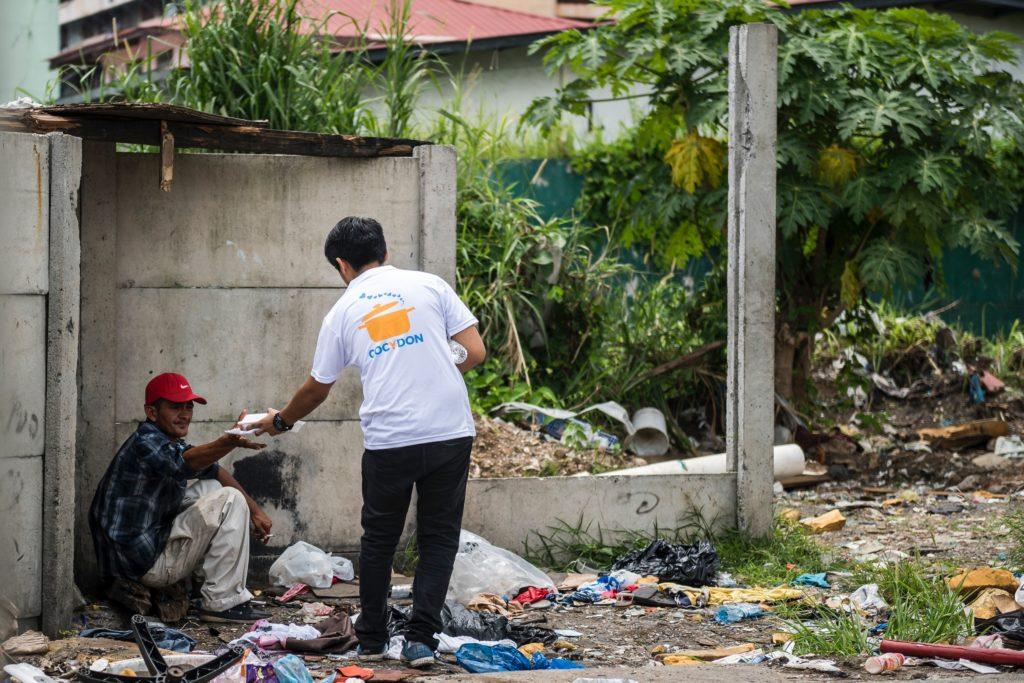 Not as much as you might think.
Not as much as you might think.
Yet people tell me all the time how much they’re afraid to ask wealthy people for major gifts. If you share those fears, it’s time for a little “Charity Clairity:”
Contrary to what your gut may be telling you, NOT asking is not making would-be donors feel good. Quite the opposite, in fact.
In this article, I’ll let you in on:
Three major donor truths. And I’ll cover why (1) you must stop short-changing your would-be major donors by not offering them opportunities to be the change they want to see in the world, and (2) you must stop robbing would-be major donors of chances to feel good about themselves.
Six major donor triggers. We’ll explore how you can make donors feel so good they’ll want to say “yes” — and passionately — to your solicitation.
Bottom line: When you don’t make donors feel good, they’ll go elsewhere.
The Rich Are Just Like You and Me
F. Scott Fitzgerald is famously supposed to have told Ernest Hemingway “the rich are different than you and I.” “Yes, Scott,” Hemingway supposedly retorted. “They have more money.”
It’s good to remember major donors are, first and foremost, just people.
They may have more money, yet many of them actually don’t even feel “wealthy” (just as often so-called seniors don’t feel “old.”) In fact, a survey of 4,000 investors by UBS found that 70% of people with investible assets of $1 million or more do NOT consider themselves “wealthy.”
What most donors share (no matter their net worth) is the existential search for meaning and the human quest to be all that one can be. To feel self-actualized.
And you can help them!
This is your job. This is part and parcel of your organization’s mission.
You (as executive management, development staff or board member) are a facilitator of philanthropy. You help those who want to affirm their significance by demonstrating their “love of humanity” (the translation, from the Latin, of philanthropy).
Your organization exists, in part, to facilitate your donor’s quest for meaning.
You do this by aligning the values your organization enacts on a daily basis with the values your donor holds dear. Ready for the truth? If your cause is meaningless to people, then you have no real purpose.
3 Truths That Will Set You and Your Donors Free
 TRUTH No. 1: Donors can only achieve their yearned-for potential through you.
TRUTH No. 1: Donors can only achieve their yearned-for potential through you.
Donors, major or otherwise, want to see themselves as good people who care about more than just themselves. Donors want to see wrongs righted, find cures for diseases, keep people from starving — but they don’t have a clue how to do it on their own.
TRUTH No. 2: Your nonprofit cannot survive unless you satisfy donors’ needs.
Donors make your mission possible. Without them, your organization has no raison d’etre. If your cause is meaningless to people, then you have no real purpose. Donors don’t give because you have needs. They give because you meet needs that align with their values. Your mission resonates with theirs.
TRUTH No. 3: The donor/nonprofit relationship is symbiotic.
It’s as much a part of your mission to help your donors as it is for you to help your clients. Because you can’t do one without the other. At least not effectively.
Philanthropists Can Make Magic Happen—With Your Encouragement!
 We’d all love to create a little magic if we could, right? The problem is most of us simply haven’t been taught how to make the magic happen.
We’d all love to create a little magic if we could, right? The problem is most of us simply haven’t been taught how to make the magic happen.
Your job, as a philanthropy facilitator, is to show donors how money, combined with awareness, becomes creative magic.
Today I’m going to focus on major donors. But this applies to mid-level donors as well. I don’t believe you must be rich to be a philanthropist. The very word, philanthropy, means “love of humanity.” Anyone can do it.
But… the rich are a little bit different. Not fundamentally, of course. But enough they warrant a different approach.
Because major-donor giving will make more of a difference to your cause, and to instilling energy into life-affirming organizations and projects, than any other form of fundraising.
Please don’t discount the importance of your role. Most people like to have their hands held. If you won’t do it, someone at some other organization will. Donors are as much “customers” as anything else, and they can always take their business elsewhere.
How to Ask Major Donors for Transformative Gifts
 Simply learn to ask in a manner that entices philanthropists to seize this moment to transform the world.
Simply learn to ask in a manner that entices philanthropists to seize this moment to transform the world.
For when it comes to money, as Dolly Levi told Horace Vandergelder:
“Money is like manure. It’s not worth a thing unless you spread it around.”
Again, your job as a philanthropy facilitator is to show your major donor prospects the best ways to spread their money so that good things spring forth from the fruits of their labor.
When I say “good things,” I’m not just talking about getting your organization a nice fat check. Nor am I just talking about the impact that check will have on your mission. I’m significantly talking about how the act of philanthropy will make your donor feel!
Show Affluent Donors How to Fulfill Their Potential
 You may be familiar with Maslow’s “Theory of Human Motivation” where he breaks down the needs for human development and contentment into steps that form a hierarchical pyramid. Maslow suggests the basic human needs such as food, shelter and sleep are required before you can pursue higher needs such as security, love and belonging, esteem, and the need for self-actualization to achieve your greatest individual human potential.
You may be familiar with Maslow’s “Theory of Human Motivation” where he breaks down the needs for human development and contentment into steps that form a hierarchical pyramid. Maslow suggests the basic human needs such as food, shelter and sleep are required before you can pursue higher needs such as security, love and belonging, esteem, and the need for self-actualization to achieve your greatest individual human potential.
Since basic needs are met for those who are affluent, it’s a bit easier to talk to them about how philanthropy can help them meet their higher level needs.
Paul Schervish, a sociologist and former Jesuit priest, endeavored to figure out how the wealthy feel about money and giving by interviewing more than 250 affluent Americans and attending exclusive gatherings where they discussed their feelings about philanthropy. For a Marxist-influenced scholar, he takes an unusually charitable attitude toward the upper crust.
Rather than bemoan the excesses of the wealth boom of recent decades, he foresees a silver and gold lining—more wealthy people finding purpose and happiness through a “philanthropic vocation.” (See Watching the Rich Give).
Understand These 6 Major Donor Philanthropic Triggers
 In 2006, the Bill and Melinda Gates Foundation awarded Schervish’s Center on Wealth and Philanthropy $600,000 to conduct a first-of-a-kind survey of the ultra-wealthy—those with a net worth of at least $25 million. The findings revealed a number of areas that trigger consideration of philanthropic giving. Consider these triggers as you develop your plans to ask for major gifts. I’ve also added one from a more recent study reported in Scientific American.
In 2006, the Bill and Melinda Gates Foundation awarded Schervish’s Center on Wealth and Philanthropy $600,000 to conduct a first-of-a-kind survey of the ultra-wealthy—those with a net worth of at least $25 million. The findings revealed a number of areas that trigger consideration of philanthropic giving. Consider these triggers as you develop your plans to ask for major gifts. I’ve also added one from a more recent study reported in Scientific American.
1. Feeling Economically Secure
The findings showed a strong correlation between feelings of economic security and a willingness to give. Individual circumstances strongly color these perceptions. My definition of economic security is not necessarily your definition. Someone with $50 million tied up in a business may feel more precarious than a person with a modest lifestyle and $5 million in safe investments.
ASK YOURSELF: Do I have reason to believe the prospect we’re approaching feels economically secure? If so, there’s no reason to fear making a major gift ask. You still may get a “no,” but you’re not compromising their health and welfare by asking.
2. Reflection
Schervish’s surveys did not just result in data collection. They had the ancillary effect of prompting reflection by respondents who reported the questions made them think hard about their philanthropic choices (or lack thereof). Often those who’ve been very successful in business have been so single-mindedly focused on making money and building power, they’ve never had time to reflect on giving. Just because someone has not been a philanthropist in the past does not necessarily mean they won’t be one in the future.
ASK YOURSELF: If I ask this prospect to reflect on making a philanthropic gift, might it help them to veer off the tunnel-visioned path they’ve been on? If so, consider yourself a true teacher and even a facilitator of what Schervish sees as “a spiritual awakening among America’s very wealthy.” You’re offering a new path towards personal fulfillment and meaning – which is kind of cool, don’t you think?
3. Community Connections
Rather than simply take their wealth and invest in new businesses or pass it to their heirs, philanthropy can be an attractive way to draw people into the same kind of direct, caring relationship they have with their family—and then multiply that feeling by extending it outwards to accomplish even greater good. Or, if they don’t have a close family connection, they can get one by approaching philanthropy as a transformational relationship (see #5, below) entered into for the benefit of all beings.
ASK YOURSELF: Has this prospect demonstrated a desire to build a closer relationship and a deeper connection with our organization and cause? If you know they value being part of your community, this is an opportunity to make them even more valued members.
4. Purpose, Happiness and Meaning
For most people, meaning is deeply intertwined with community connections. Humans want to feel a sense of connection and purpose to life. Giving (time, money and energy) is a central way we strive to find meaning. By expanding their vision of helping outside the confines of their family and business, innovative philanthropists intensely engage the human experiment and are willing to direct their full resources towards human betterment.
ASK YOURSELF: Does this prospect like to feel like a “big shot” and, if so, am I prepared to show them philanthropy offers a path unlike any other? If you can show these philanthropists a need that offers an expansive, powerful vision, they will respond precisely because, when they do so, it will create not just ripples but powerful tides.
5. Independence and Self-Reliance
A scholarly paper by psychologists Ashley Whillans, Eugene Caruso, and Elizabeth Dunn suggests another explanation as to what triggers philanthropic giving by wealthier donors. It’s related to the notion that people give when doing so resonates strongly with their self-image. Across three studies, they found:
-
Those who earn $40,000 or less are more likely to donate to when presented with a request emphasizing social connection and community.
-
Those with an income of $90,000 or above are more likely to give when presented with a request appealing to their sense of independence and self-reliance.
The studies are fascinating. They compared two donation appeals.
- Half of the participants read an “agentic” appeal characterizing The Life You Can Save organization as one that spreads “knowledge of what each person can do individually to reduce poverty.” Wealthier participants were more likely to click “Donate” when presented with the agentic appeal.
- The other participants read a “communal” appeal that said the organization spreads “knowledge of what all of us can do together to reduce poverty.” Less wealthy participants were more likely to click “Donate” when presented with the communal appeal.
- The researchers found no relationship between clicking on the donation link and gender, ethnicity, or age.
Past research from behavioral economists backs this up, showing people with higher incomes tend to have a greater sense of personal control. Money allows people to meet their personal goals without needing to rely so much on others, and this may affect how they see themselves. Additional research shows people with lower incomes tend to see themselves as more connected to others, maybe because they need to rely more other people in their everyday lives.
ASK YOURSELF: Does my prospect view themselves as fiercely self-confident and autonomous? If so, whether they behave selfishly or generously may depend less on what they have and more on whether your request makes them feel like the person they see themselves being or becoming.
6. Transformation
To create life-long donors requires meeting their highest-level need. Maslow describes this as “identification”—where donors incorporate their affiliation with you as part of their being (e.g., “I am a Greenpeace donor;” “I am a social justice warrior.”). In non-psychological or theoretical terms, they just feel darn good. They carry around a warm glow, representing the realization of their full potential and inner peace. This feeling is very powerful—and we naturally seek it out—which is one of reasons why even very poor give outsized proportions of their income to charity.
ASK YOURSELF: How can I facilitate my prospect’s sense of identification as a good person? One of the most significant trends in giving involves seeing philanthropy as an act that not only helps someone else, but changes the philanthropist also.
Philanthropy helps philanthropists too. So don’t fear asking.
At the end of the day, no one feels bad about having made an outsized impact on an issue that’s near and dear to their heart. When you help your donors, while simultaneously helping your cause, fundraising becomes a true win/win.
Learn to tailor your major donor approaches to major donor psychology, philanthropic triggers and personal motivations and everyone will come out ahead.
And always remember: donors are people first.
Ready to Become a Major Gifts Fundraising Wizard?
 Whether you’re new to raising major gifts or have had a program for a while, this four-volume Major Gifts Playbook will enable you to take things to the next level. There’s nothing else you can do that will have such an enormous impact on your bottom line. You need a systematic plan for identifying, screening, qualifying and beginning to build relationships with viable prospects before you’re ready to approach them for a gift. And that’s exactly what you’ll learn in this Playbook!
Whether you’re new to raising major gifts or have had a program for a while, this four-volume Major Gifts Playbook will enable you to take things to the next level. There’s nothing else you can do that will have such an enormous impact on your bottom line. You need a systematic plan for identifying, screening, qualifying and beginning to build relationships with viable prospects before you’re ready to approach them for a gift. And that’s exactly what you’ll learn in this Playbook!
Exactly what to do – and when and how to do it. Includes hands-on worksheets, exercises and checklists, plus practical tips. Get the full set at a discount.
Featured image courtesy of Ron Lach on Pexels





